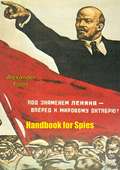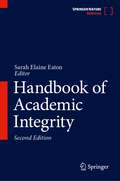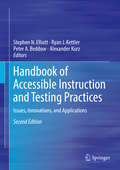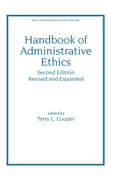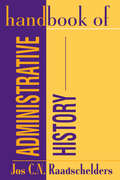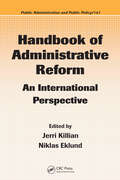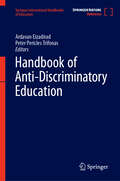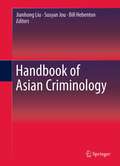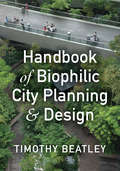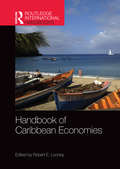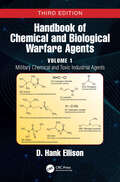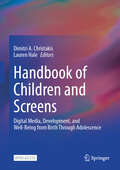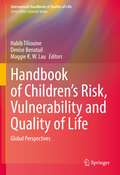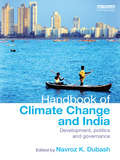- Table View
- List View
Handbook for Spies
by Alexander FooteSeeking adventure, British citizen Alexander Foote fought the Fascists in the Spanish Civil War. Returning home after it ended, discouraged by the result, Foote was recruited into a Soviet network of spies against Nazi Germany. Based in Switzerland, Foote eventually became responsible for maintaining the network and forwarding information to the Centre in Russia. Foote describes for us how the network operated, including codes and secret transmissions, hiding from Swiss and German authorities, recruiting and funding, and eluding double agents. All the while, Foote watches Soviet Russia, presumably an ally to the free nations, become more and more like the Fascists Foote opposes. Eventually captured by Swiss police, Foote is debriefed in Russia, but manages to escape home to Britain after persuading the Soviets to send him on another mission. This is a fascinating story that illuminates a key part of the secret espionage networks undertaken during World War II.
Handbook of Academic Integrity
by Sarah Elaine EatonThe book brings together diverse views from around the world and provides a comprehensive overview of academic integrity and how to create the ethical academy. At the same time, the Handbook does not shy away from some of the vigorous debates in the field such as the causes of academic integrity breaches. There has been an explosion of interest in academic integrity in the last 20-30 years. New technologies that have made it easier than ever for students to ‘cut and paste’, coupled with global media scandals of high profile researchers behaving badly, have resulted in the perception that plagiarism is ‘on the rise’. This, in combination with the massification and commercialisation of higher education, has resulted in a burgeoning interest in the importance of academic integrity, how to safeguard it and how to address breaches appropriately. What may have seemed like a relatively easy topic to address – students copying sources without attribution – has in fact, turned out to be a complex, interdisciplinary field of research requiring contributions from linguists, psychologists, social scientists, anthropologists, teaching and learning specialists, mathematicians, accountants, medical doctors, lawyers and philosophers, to name just a few.Because of this broad interest and input, this handbook serves as the single authoritative reference work which brings together the vast, growing, interdisciplinary and at times contradictory body of literature. For both established researchers/practitioners and those new to the field, this Handbook provides a one-stop-shop as well as a launching pad for new explorations and discussions.
Handbook of Accessible Instruction and Testing Practices: Issues, Innovations, And Applications
by Ryan J. Kettler Alexander Kurz Peter A. Beddow Stephen N. ElliottThe Second Edition of this handbook provides comprehensive coverage of the concept of accessibility and its application to the design and implementation of instruction and tests with all students. It updates and expands on its original contents and responds to the increasing demand for research-based evidence of accessible instruction and testing practices from the professional community. Chapters explore how outcomes are affected when essential features or components of instructional materials and tests are not accessible to any portion of the student population. The handbook addresses the new set of Standards for Educational and Psychological Testing that was published in 2014 as well as requirements for a high level of access for all interim and summative tests by national testing consortiums. In addition, the handbook describes how the Center for Applied Special Technology (CAST) has continued to advance Universal Design for Learning (UDL) principles in mainstream education with teachers of all types of students, not just students with disabilities.Topics featured in this text include: A summary of U.S. policies that support inclusive assessment for students with disabilities. An overview of international policies that support inclusive assessments. Designing, developing, and implementing an accessible computer-based national assessment system. Universal Design for Learning (UDL) principles and the future of assessment. Recent advancements in the accessibility of digitally delivered educational assessments. The Handbook of Accessible Instruction and Testing Practices, Second Edition is an essential reference for researchers, practitioners, and graduate students in education and allied disciplines, including child and school psychology; assessment, testing and evaluation; social work; and education policy and politics.
Handbook of Administrative Communication (Public Administration and Public Policy)
by Alexander Kouzmin James L. GarnettThis volume takes a communications-oriented approach to a wide range of topics encompassing organization, management, political theory and practice, business-government relations, innovation processes, and IT. Offering a balanced, international presentation, it contains authoritative contributions from world-renowned experts representing various disciplines, including administrative law, organizational and political theory, phenomenology, public and business management, educational technology, psychology, and other fields. The book addresses typically neglected subjects such as communicating through humor, drama, film, poetry, fiction, and other creative forms.
Handbook of Administrative Ethics
by Terry CooperDelineating implications for administrative ethics from other fields such as sociology, psychology, and philosophy, this reference provides a comprehensive review of administrative ethics in the public sector. Detailing the context within which contemporary ethics training has developed, the book examines the effectiveness of ethics training, legal and organizational devices for encouraging desired conduct, and other topics of particular relevance to the political and social contexts of public administration. Written by over 25 leading scholars in public administration ethics, the book creates a taxonomy for administrative ethics using the categories of modern philosophy.
Handbook of Administrative History
by Jos RaadscheldersPublic administration is commonly assumed to be a young discipline, rooted in law and political science, with little history of its own. Likewise, teaching and scholarship in this field is often career oriented and geared either toward the search for immediately usable knowledge or guidelines and prescriptions for the future. Although most administrative scientists would acknowledge that their field has a history, their time horizon is limited to the recent past. Raadschelders demonstrates that public administration has in fact a long-standing tradition, both in practice and in writing; administration has been an issue ever since human beings recognized the need to organize themselves in order to organize the environment in which they lived. This history, in turn, underlines the need for administrators to be aware of the importance and contemporary impact of past decisions and old traditions. In seeking to go beyond the usual problem-solving and future-oriented studies of public administration, this volume adds greatly to the cognitive richness of this field of research. Indeed, the search for theoretical generalizations will profit from an approach that unravels long-term trends in the development of administration and government."Raadschelders approaches public administration history from a dual perspective, as trained historian and professor of public administration.... The volume is appropriately called a aehandbook' in view of its methodical listing of the literature on administrative history, together with summaries of numerous authors' principal theories. The second chapter is an essay on sources in the field, including an extended bibliography.... These parts of the book alone make it useful to scholars in the field.... Raadschelders is helpful in other ways as well. The third and fourth chapters offer a highly sophisticated discussion of methodological problems encountered in writing administrative history, including the issue of perceiving 'stage
Handbook of Administrative Reform: An International Perspective (Public Administration and Public Policy)
by Jerri Killian Niklas EklundThe field of public administration currently lacks sufficient resources for understanding the rationale, implications, and inherent practices of reforming government administration around the world.The Handbook of Administrative Reform satisfies this need by bringing together diverse international experts to analyze the sensible processes an
Handbook of Adverse Childhood Experiences: A Framework for Collaborative Health Promotion (Issues in Clinical Child Psychology)
by Michael C. Roberts Sharon G. Portwood Michael J. LawlerThis handbook explores ways to unify the study and application of adverse childhood experiences (ACEs) across multiple fields and disciplines, including clinical child and adolescent psychology, school psychology, pediatrics, social work, public health, education, and other health and human services. The book outlines a cohesive framework that organizes critical ACEs concepts throughout individual chapters, highlighting key issues and themes across settings and disciplines as well as gaps in current knowledge. Chapters examine interdisciplinary and collaborative approaches to ACEs and their impact on health and well-being within a specific topic area or setting. In addition, chapters review the foundations and development of the relevant science and provide examples of ACEs research and intervention applications as well as suggestions for continued advancement in this field. Key areas of coverage include: Definition and measurement of ACEs. Theory and models guiding ACEs research and practice. Applications of ACEs science across settings, including healthcare, mental and behavioral health, schools, justice system, and child welfare system. Applications of ACEs to public health and policy issues. Prevention strategies and policy approaches to ACEs. Handbook of Adverse Childhood Experiences is an essential resource for researchers, professors, and graduate students as well as clinicians and related mental health and medical therapists and professionals in developmental and clinical child and adolescent psychology, school psychology, child and adolescent psychiatry, social work, child and family studies, public health, pediatrics, and all interrelated disciplines.
Handbook of Anti-Discriminatory Education (Springer International Handbooks of Education)
by Peter Pericles Trifonas Ardavan EizadiradThis comprehensive handbook addresses issues related to anti-discriminatory education as it relates to children, youth, young adults, families, and practitioners across a series of age groups, sectors, communities, and countries. It seeks to map a holistic interdisciplinary overview of the field examining how policies, practices, and initiatives within unique social, political, and cultural contexts have been enacted to advance anti-discriminatory education for improved equity, diversity, and inclusion outcomes leading to thriving school-community ecosystems. The work draws on a range of theoretical frameworks, hybrid perspectives, and research projects to provide multiple examples about the challenges, complexities, and nuances involved in theorizing and doing the work of anti-discriminatory education in local communities and on a macro institutional level. With intentionality, authors from various backgrounds, identities, fields, and positionalities describe and discuss various social justice and equity issues and how they strategize, mobilize, and navigate unique micro and macro dynamics affiliated with power and privilege for the purpose of advancing the field of anti-discriminatory education. Overall, the chapters cover a range of topics and issues from various practitioners and community perspectives around the intersectionality and divergence of navigating micro lived experiences and macro institutional policies and practices to bridge the gap between theory and action with respect to anti-discriminatory education. The book is divided into 4 sub-sections: Early Childhood Education (Early years up to approx. 10 years old), Elementary and Middle School Years (approx. 11 to 14 years old), Secondary Schools (approx. 15 to 19 years old), and Higher Education (Post-Secondary).
Handbook of Applied Journalism: Theory and Practice (Springer Handbooks of Political Science and International Relations)
by Leon Barkho Sadia Jamil Jairo Alfonso Lugo-OcandoThis authoritative handbook looks at the entire news cycle and provides a bridge between the theoretical and academic study of journalism and its actual contemporary practice. The book's main merit is that it brings theory and practice together, with contributors discussing these issues from different perspectives in a way that scholars, students, and practitioners can find useful in the study of journalism. The handbook is also unique as it undertakes an international scope across regions and cultures, both from the West and the Global South, while providing an overview which balances the (over-) emphasis on content in most academic approaches to journalism.The book is divided into four major parts: (1) Conceptual foundations, (2) Interlink between journalism as scholarship and journalism as practice, (3) Regions and cultures, and (4) The practitioner world. The first two sections lay down the foundation for section (3) which provides an overview of journalism practice in different regions and cultures. Section (4) includes contributions by practitioners in which they attempt to respond to some of the issues raised in preceding sections.This handbook will appeal to academics, practitioners, and professionals alike, who are interested in a better understanding of the academic study of journalism and its actual contemporary practice.
Handbook of Asian Criminology
by Susyan Jou Bill Hebenton Jianhong LiuThe Handbook of Asian Criminology aims to be a key reference for international scholars with an interest in the broad theme of international criminology in general, and the Asian region in particular. Contextualization is a key theme in this book. The role of context is often underemphasized in international criminology, so the Handbook of Asian Criminology's premise that crime and the responses to it are best understood as deeply embedded in the cultural specificity of the environment which produces them will play a key role throughout the work. Attention will be given to country- and region specific attitudes towards crime and punishment.
Handbook of Biophilic City Planning & Design
by Timothy BeatleyWhat if, even in the heart of a densely developed city, people could have meaningful encounters with nature? While parks, street trees, and green roofs are increasingly appreciated for their technical services like stormwater reduction, from a biophilic viewpoint, they also facilitate experiences that contribute to better physical and mental health: natural elements in play areas can lessen children's symptoms of ADHD, and adults who exercise in natural spaces can experience greater reductions in anxiety and blood pressure.The Handbook of Biophilic City Planning & Design offers practical advice and inspiration for ensuring that nature in the city is more than infrastructure--that it also promotes well-being andcreates an emotional connection to the earth among urban residents. Divided into six parts, the Handbook begins by introducing key ideas, literature, and theory about biophilic urbanism. Chapters highlight urban biophilic innovations in more than a dozen global cities. The final part concludes with lessons on how to advance an agenda for urban biophilia and an extensive list of resources.As the most comprehensive reference on the emerging field of biophilic urbanism, the Handbook is essential reading for students and practitioners looking to place nature at the core of their planning and design ideas and encourage what preeminent biologist E.O. Wilson described as "the innate emotional connection of humans to all living things."
Handbook of Bureaucracy (Public Administration And Public Policy Ser. #55)
by Ali FarazmandThis encyclopedic reference/text provides an analysis of the basic issues and major aspects of bureaucracy, bureaucratic politics and administrative theory, public policy, and public administration in historical and contemporary perspectives. Examining theoretical, philosophical, and empirical interpretations, as well as the intricate position of b
Handbook of Caribbean Economies (Routledge International Handbooks)
by Robert E. LooneyThis volume aims to illustrate the uniqueness of the economies of the countries and territories of the Caribbean as well as the similarities they share with other regions. While most countries in the region share many of the characteristics of middle-income countries, theirs is a matter of extremes. Their generally small size suggests a fragility not found elsewhere. While much of the world is beginning to feel some effects of climate change, the Caribbean is ground zero. These factors suggest a difficult road ahead, but the chapters presented in this volume aim to help to spur the search for creative solutions to the region’s problems. The chapters, written by expert contributors, examine the Caribbean economies from several perspectives. Many break new ground in questioning past policy mindsets, while developing new approaches to many of the traditional constraints limiting growth in the region. The volume is organized in four sections. Part I examines commonalities, including issues surrounding small economies, tourism, climate change and energy security. Part II looks at obstacles to sustained progress, for example debt, natural disasters and crime. In Part III chapters consider the specific role of external influences, including the USA and the European Union, the People's Republic of China, as well as regional co-operation. The volume concludes in Part IV with country case studies intended to provide a sense of the diversity that runs through the region.
Handbook of Central American Governance
by Diego Sánchez-Ancochea and Salvador Martí i PuigCentral America constitutes a fascinating case study of the challenges, opportunities and characteristics of the process of transformation in today’s global economy. Comprised of a politically diverse range of societies, this region has long been of interest to students of economic development and political change. The Handbook of Central American Governance aims to describe and explain the manifold processes that are taking place in Central America that are altering patterns of social, political and economic governance, with particular focus on the impact of globalization and democratization. Containing sections on topics such as state and democracy, key political and social actors, inequality and social policy and international relations, in addition to in-depth studies on five key countries (Costa Rica, Nicaragua, El Salvador, Honduras and Guatemala), this text is composed of contributions from some of the leading scholars in the field. No other single volume studies the current characteristics of the region from a political, economic and social perspective or reviews recent research in such detail. As such, this handbook is of value to academics, students and researchers as well as to policy-makers and those with an interest in governance and political processes.
Handbook of Chemical and Biological Warfare Agents, Volume 1: Military Chemical and Toxic Industrial Agents (Handbook Chemical & Biological Warfare Agents 3e)
by D. Hank EllisonThe Handbook of Chemical and Biological Warfare Agents, Volume 1: Military Chemical and Toxic Industrial Agents, Third Edition provides rapid access to key data to response professionals and decision-makers on a broad range of agents and pathogens. This volume examines military chemical agents that were developed for their lethal effects and includes chapters on nerve agents, vesicants, urticants, convulsants, blood agents, and pulmonary agents. It also details toxic industrial materials that are considered potential threat for use as improvised agents. In addition to a discussion of each of these classes of agents, coverage includes detailed information on a broad spectrum of individual agents that have been used on the battlefield, stockpiled as weapons, used or threatened to be used by terrorists, or have been otherwise assessed by qualified law enforcement and response organizations and determined to be agents of significant concern The information presented in this edition has been updated and expanded; containing more information on toxicology, health effects, chemical and physical properties of individual agents, as well as protective actions needed at the scene of an incident. Key Features: Focuses on key information needed during an emergency response Provides updated toxicology, exposure hazards, physical-chemical data, and best practices with regard to the treatment of casualties Presents updated protective action distances, decontamination, and remediation information All data compiled is gathered from numerous sources and arranged into the current, easy-to-access format. In order to ensure accuracy, all data has been cross-checked over the widest variety of military, scientific and medical sources available. The Handbook of Chemical and Biological Warfare Agents, Volume 1: Military Chemical and Toxic Industrial Agents, Third Edition remains the gold-standard reference detailing the widest variety of military, scientific, and medical sources available
Handbook of Chemical and Biological Warfare Agents, Volume 2: Nonlethal Chemical Agents and Biological Warfare Agents (Handbook Chemical & Biological Warfare Agents 3e)
by D. Hank EllisonThe Handbook of Chemical and Biological Warfare Agents, Volume 2: Pathogens, Mid-Spectrum, and Incapacitating Agents, Third Edition provides rapid access to key data to response professionals and decision-makers on a broad range of agents and pathogens. This volume presents information on a wide range of chemical and biological agents. Chemical agents detailed in this volume are those that were developed specifically for their non-lethal potential. The biological agents described are militarily significant pathogens that could be weaponized to pose a threat to people, animals, or crops and other agricultural interests. Mid-spectrum agents, materials that do not fit clearly into either the Chemical or the Biological Weapons Conventions, include toxins and bioregulators. Entomological agents, the final class of agents discussed in volume, are arthropods that could pose a significant threat to a country’s agriculture infrastructure and be used to devastate its economy. They were proposed for inclusion in the Biological Weapons Convention but never adopted. In addition to a discussion of each of these classes of agents, coverage includes detailed information on a broad spectrum of individual agents that have been used on the battlefield, stockpiled as weapons, used or threatened to be used by terrorists, or have been otherwise assessed by qualified law enforcement and response organizations and determined to be agents of significant concern. The information presented in this edition has been updated and expanded to contain more information on toxicology, health effects, presentation of diseases, advances in medical care and treatment, as well as protective actions needed at the scene of an incident. Key Features: Focuses on the key information needed during an emergency response Provides updated toxicology, exposure hazards, physical-chemical data, and treatment of casualties Profiles the presentation of diseases in people, animals and plants Presents updated protective action distances, decontamination, and remediation information All data compiled is gathered from numerous sources and arranged into the current, easy-to-access format. In order to ensure accuracy, all data has been cross-checked over the widest variety of military, scientific and medical sources available. The Handbook of Chemical and Biological Warfare Agents, Volume 2: Pathogens, Mid-Spectrum, and Incapacitating Agents, Third Edition remains the gold-standard reference detailing the widest variety of military, scientific, and medical sources available.
Handbook of Children and Screens: Digital Media, Development, and Well-Being from Birth Through Adolescence
by Dimitri A. Christakis Lauren HaleThis open access handbook synthesizes the current research about the impacts of digital media on children across development. Drawing on the expertise of scientists and researchers as well as clinicians and practitioners, the book summarizes research through interdisciplinary expert reviews. First, it addresses the cognitive, physical, mental, and psychosocial impacts on infants, children, and adolescents. Next, the book explores how media influences relationships, family, culture, and society. Finally, it examines the impacts of specific digital domains pertinent to youth, including education technology, video gaming, and emerging technologies. Chapters employ a parallel structure, including background on the topic, summary of the current state of the research, future research directions, and recommendations for relevant stakeholders. The volume examines the timely issue of optimal child development in an increasingly digital age, offering innovative approaches to establish a solid and robust scientific foundation for this field of study as well as evidence-based action for adults who support positive youth development. Key areas of coverage include: • Cognition and brain development. • Physical and mental health. • Problematic uses of the internet. • Race. • Gender and sexuality. • Parenting in the digital age. • Cyberbullying and digital cruelty. • Media policy. The Handbook of Children and Screens is a must-have resource for researchers, professors, and graduate students as well as clinicians, therapists, educators, and related professionals in clinical child, school, and developmental psychology, social work, public health, epidemiology, neuroscience, human development and family studies, social psychology, sociology, and communication. This is an open access book.
Handbook of Children’s Risk, Vulnerability and Quality of Life: Global Perspectives (International Handbooks of Quality-of-Life)
by Habib Tiliouine Maggie K. W. Lau Denise BenatuilThis handbook makes a major contribution to the growing international research and policy interest in children’s experienced well-being or quality of life in childhood, linking it to ongoing research on children’s risk and vulnerability. The editors and contributors adopt the broader concept of ‘risk’ in addition to ‘vulnerability’. Not much work considers the connections between risks that children experience and their quality of life. In examining children’s quality of life, the chapters discuss various issues of risk and vulnerability that may affect their lives and also how the quality of childhood might be enhanced and maintained even in the face of these factors. The chapters discuss experiences of violence and abuse; access to basic services such as housing, health and education; and children’s vulnerability due to broader external factors such as war, conflict, and environmental events. The volume also includes the impacts of new technologies on children and the consequent risks and vulnerabilities they may face, alongside the benefits.This important volume brings together a diverse range of perspectives from established experts and emerging scholars in these fields of work. It covers a wide range of geographical and cultural contexts, and includes theoretical, empirical, policy and practice-based contributions. This handbook is a natural first point of reference for academics and policy professionals interested in quality of life, well-being, and children's rights.
Handbook of China’s Governance and Domestic Politics (Routledge International Handbooks Ser.)
by Chris OgdenThis Handbook provides an in-depth overview of how China is governed, how its domestic political system functions and the critical issues that it currently faces. Governed by the world’s largest political party in the world’s longest-ruling Communist regime, China is undergoing a transitional period of rapid economic and social development. How this period is managed will have significant implications for the Chinese state and its population concerning China’s governance structures and economy, as well as the country’s justice, public health, education and internal/external security concerns. This transition to a modern state is not without its challenges – particularly in terms of how the Chinese state deals with diverse issues such as social inequality, corruption, separatism, increasing individualism and political reform. China’s governance and domestic politics also have possible major global consequences, especially in the context of China's continued rise within the international system. This Handbook will improve understandings of the core national dynamics of this rise and, as levels of international interdependence with China increase, can offer vital insights concerning China's domestic attributes. Gaining a better knowledge of China's internal workings can also help better appreciate the multiple and varied problems that China’s leaders will face in the coming decades. Critically, many of the core internal issues facing China also have potential external repercussions, principally in terms of rising social unrest, nationalism, environmental degradation, resource shortages and attitudes towards globalization. This book aims to cover these issues and will help readers to fully comprehend China’s ongoing contemporary global significance.
Handbook of Chinese Economics
by Zhuoyuan ZhangThis book reviews the development of Chinese economics since the reform and opening-up, associated with the history and experience of China's economic growth. This book makes a systematic study of the direction of reform, the method of reform, the path of reform, the main body of reform and the motive force of reform, accumulates more experiences that can be used for reference for the exploration of new reforms to be opened, and probes into the way of reform in the next period. The topics cover all key concepts and theories relating to the China's economic reform.
Handbook of Civil Society and Social Movements in Small States (Europa International Perspectives)
by Lino Briguglio Claire Slatter Michael Briguglio Sheila BunwareeThis volume is unique because of its focus on small states. There are many studies on civil society and social movements, but none that specifically deal with this category of countries. As is well known, small states have particular characteristics, including a limited ability to reap the benefits of economies of scale, a high degree of exposure to forces outside their control, and the proximity of politicians to the voters, often leading to clientelistic relationships and patronage networks. The small island developing states have the additional problem of high environmental vulnerability, with some also dealing with disproportionate ecological footprints. These factors have a bearing on the organization and performance of civil society organizations and social movements, as explained in several chapters of this book. The volume is organized in three parts, dealing with aspects of civil society and social moments in small states in the political, social and environmental spheres, respectively. Various definitions of civil society are proposed in the chapters, but most authors associate the term with organized groups, operating in the interest of citizens, independently of government and commercial business, including various forms of non-governmental organizations (NGOs). Civil society also encompasses social movements, which are considered to be loosely organized collective campaigns in pursuit of social goals. These two terms are sometimes used interchangeably; however, some authors argue that social movements tend to engage in ‘contentious politics’ including protests, while NGOs engage through more organized and institutional routes.
Handbook of Civil Society and Social Movements in Small States (Europa International Perspectives)
by Lino BriguglioThis volume is unique because of its focus on small states. There are many studies on civil society and social movements, but none that specifically deal with this category of countries. As is well known, small states have particular characteristics, including a limited ability to reap the benefits of economies of scale, a high degree of exposure to forces outside their control, and the proximity of politicians to the voters, often leading to clientelistic relationships and patronage networks. The small island developing states have the additional problem of high environmental vulnerability, with some also dealing with disproportionate ecological footprints. These factors have a bearing on the organization and performance of civil society organizations and social movements, as explained in several chapters of this book. The volume is organized in three parts, dealing with aspects of civil society and social moments in small states in the political, social and environmental spheres, respectively. Various definitions of civil society are proposed in the chapters, but most authors associate the term with organized groups, operating in the interest of citizens, independently of government and commercial business, including various forms of non-governmental organizations (NGOs). Civil society also encompasses social movements, which are considered to be loosely organized collective campaigns in pursuit of social goals. These two terms are sometimes used interchangeably; however, some authors argue that social movements tend to engage in ‘contentious politics’ including protests, while NGOs engage through more organized and institutional routes.
Handbook of Civil Society in Japan (Handbooks on Japanese Studies)
by Akihiro Ogawa Simon AvenellCivil society in Japan is a large and multifaceted sphere with a diversity of actors pursuing various social, political, and economic objectives. The sphere has experienced major waves of transformation in the post-1945 era, especially in the 1990s when volunteering and nonprofit activities came to the forefront of political and popular attention. This handbook brings together twenty-one leading experts to provide comprehensive and up-to-date analyses of civil society in Japan. What is the history of Japanese civil society and how has it evolved in recent decades? Who have been the key participants and what are their objectives? How have international actors and conditions influenced civil society in Japan? More broadly, what do recent developments in Japanese civil society tell us about the condition of democracy, state-society relations, and the public sphere in the country? And how might Japanese civil society develop into the future? The contributions to the handbook offer innovative perspectives based on the most-recent fieldwork and data available. The handbook is divided into three sections: Institutions, Justice and Transnationalism. Topics include nonprofit organizations, volunteering, philanthropy, new media, gender, pacifism, nuclear power, territorial politics, international cooperation and transnational solidarity. The volume will be valuable for scholars in both research and teaching as well as essential reading for anyone wanting to understand the diversity and vibrancy of Japanese civil society today.
Handbook of Climate Change and India: Development, Politics and Governance (Routledge Environment and Sustainability Handbooks)
by Navroz K. DubashHow do policymakers, businesses and civil society in India approach the challenge of climate change? What do they believe global climate negotiations will achieve and how? And how are Indian political and policy debates internalizing climate change? Relatively little is known globally about internal climate debate in emerging industrializing countries, but what happens in rapidly growing economies like India’s will increasingly shape global climate change outcomes. This Handbook brings together prominent voices from India, including policymakers, politicians, business leaders, civil society activists and academics, to build a composite picture of contemporary Indian climate politics and policy. One section lays out the range of positions and substantive issues that shape Indian views on global climate negotiations. Another delves into national politics around climate change. A third looks at how climate change is beginning to be internalized in sectoral policy discussions over energy, urbanization, water, and forests. The volume is introduced by an essay that lays out the critical issues shaping climate politics in India, and its implications for global politics. The papers show that, within India, climate change is approached primarily as a developmental challenge and is marked by efforts to explore how multiple objectives of development, equity and climate mitigation can simultaneously be met. In addition, Indian perspectives on climate negotiations are in a state of flux. Considerations of equity across countries and a focus on the primary responsibility for action of wealthy countries continue to be central, but there are growing voices of concern on the impacts of climate change on India. How domestic debates over climate governance are resolved in the coming years, and the evolution of India’s global negotiation stance are likely to be important inputs toward creating shared understandings across countries in the years ahead, and identify ways forward. This volume on the Indian experience with climate change and development is a valuable contribution to both purposes.
